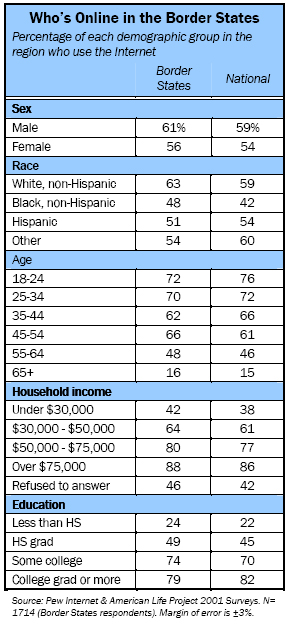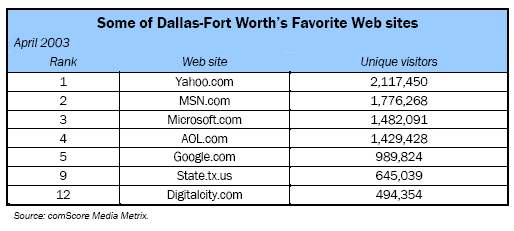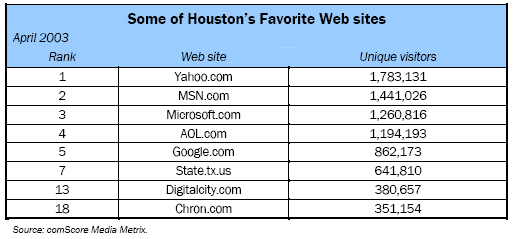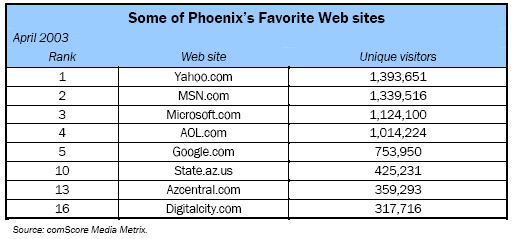The Border States make up one of the more highly wired regions of the country.
Internet users in these three states (Texas, New Mexico, Arizona) also stand out for a number of reasons:
- The Border States have one of the largest concentrations of Hispanic users in the country.
- Border States Internet users tend to have less education and lower household incomes than the national average.
- Users in the Southwest are among the most likely to have gotten news online.
- Border States users are also more likely to use the Internet for job research than users in other parts of the country.
- Southwestern users tend to be very enthusiastic about the positive effects of the Internet on different aspects of their lives.
Growth in the proportion of adults using the Internet has leveled off in the Border States. As in some other regions (the Mid-Atlantic, the Industrial Midwest) growth in Internet usage among adults in the Border States leveled off between 2001 and 2002. In 2002, 60% of adults in the region reported they were Internet users, which is only one percentage point higher than the access rate in 2001. By comparison, national Internet penetration stood at 59% in 2002 and 56% in 2001. In 2000, 53% of adults in the Southwest had used the Internet, higher than the 50% of adults nationally. While the Border States region has traditionally been more highly wired than other regions of the country, the slowdown in growth is notable.
Internet users in this region have average levels of online experience, but their income and education levels are lower.
The experience level of Internet users in the Border States is about the same as the national average. In 2001, about 45% of users in the Southwest were Internet veterans with three or more years of online experience. This is virtually the same as the national average of 44%. About 33% of users in the Border States region have been online for two to three years, 13% have about a year’s worth of experience, and about 8% are Internet rookies with six months or less of Web time. These proportions are virtually the same as the averages for the nation as a whole, where 34% of users have been online for two to three years, 15% have been online for a year, and 8% are new to the Internet. Relative to other regions of the country, the Border States are squarely in the middle when it comes to online experience. The National Capital region (50%) and the Pacific Northwest (50%) have higher proportions of veteran users, but the Border States are well ahead of the South (where 36% are Web vets) and the Upper Midwest (40%).

The household income and education levels of Web users in the Border States are below the national averages. About 31% of users in the Southwest possess college diplomas or other advanced degrees. This is about 5 percentage points less than the national average of 36%. The proportion of college-educated users is the second lowest in the country after the South, where only 28% of users are similarly educated. By comparison, about 41% of Internet users in New England are college graduates. About a third (34%) of users in the Southwest have had some college experience, slightly higher than the national average of 30%; about 29% of Border States users have high-school diplomas, and about 6% have less than a high-school education. These proportions are exactly the same nationally – 29% of users nationwide have a high-school education, and 6% possess less than a high-school education.
Compared with other regions of the country, the proportion of users with less than a high-school education in the Southwest is one of the largest. The lower level of education among users in the Border States is, among other things, explained by the relative youthfulness of the user population.
Household income distribution among Internet users in the Border States is concentrated at the extremes – the region has a large proportion of wealthy users, as well as having the largest proportion of users earning modest household incomes. Wealthy users earning over $75,000 a year constitute 24% of the Southwestern user population, while 23% of users there earn less than $30,000. The proportion of wealthy users in the Southwest is slightly larger than the national average of 23%. At the same time, the proportion of low-income users in the Southwest is the largest in the country, and is greater than the national average of 19%. Meanwhile, another 23% of users in the Southwest earn between $30,000 and $50,000 a year, while another 16% earn between $50,000 and $75,000. Nationwide, 22% and 19% of users earn those amounts, respectively.20
There is a large proportion of Hispanic Internet users, and the user population is slightly more female and slightly younger than elsewhere.
The Border States are tied with California for having the largest proportion of Hispanic21 users in the country at 21%, more than twice the national average of 9%. The region with the next highest proportion of Hispanic Web users is the Southeast (which includes Florida), where 14% of users identify themselves as Hispanics. Clearly, this statistic is influenced by the great numbers of Hispanics who live in the Border state region. Meanwhile, 67% of the users in the Southwest are whites, almost 11 percentage points lower than the national rate of 78%–the second lowest proportion of white users anywhere in the country. (California has the smallest proportion of white users, about 62%). African-Americans make up about 9% of the Southwestern Internet population, just a touch higher than the national average (8%). An additional 4% of the user population is made up of other races and ethnicities.
The user population is slightly more female and slightly younger than elsewhere.
In terms of gender, the user population in the Border States has slightly more females than males – females make up about 52% of users. Nationally, the ratio is 50-50. The Border States are one a few regions of the country with a larger proportion of women than men – the Mid-Atlantic region (54% women), the Industrial Midwest (51%), the Midwest (52%), and the Mountain region (53%) all have more women users.
The user population of the Border States is slightly younger than the national user population. In the region, about 19% of users are young adults between 18 and 24, and 26% are between 25 and 34. Nationally, 17% of users are between 18 and 24, and 23% are between 25 and 34. The proportion of users in the 18-to-24 age bracket is one of the largest in the country, behind only California (20%). At the same time, the proportion of users in the 25-to-34 age bracket is the largest of any region in the country. Meanwhile, 25% of users in the Border States are between 35 and 44, 18% are aged between 45 and 54, and about 12% are over 55. Nationally, 26% of users are between 35 and 44, 20% are between 45 and 54, and about 14% are over 55.
About 64% of users in the Border States are employed full time, equal to the national average of 64%. And 13% have part-time jobs – the national average is 14%.
Users in the Border States have some distinct preferences when they use the Internet.
Internet users in the Border States region enjoy the Web’s most popular activities at much the same rate as their peers, whether they are getting news or logging on just for fun.
Fully 64% of users in the region have gone online to get news, the highest rate of any region in the country and a figure over the national average of 59%. By comparison, Southerners (63%) are almost as enthusiastic about online news, while only 53% of users in the Pacific Northwest have turned to the Internet for news.
Another Web activity that the region’s users like is surfing online — “just for fun.” About 64% of Web users in the Border States have done this, compared with about 61% of users nationwide. This proportion is one of the largest in the country, behind 70% of users in the Midwest and 67% of users in the South. By contrast, only 49% of users in the Pacific Northwest claim to have gone online for no real reason.
Using the Web at work for research purposes is one online activity that is more popular in this region than in other parts of the country. In the Border States, about 44% of users have done this – nationally, about 41% have done so. The proportion of users in the Border States is the second largest in the country, behind only New England (45%). In contrast, only 38% of users in the Pacific Northwest and only 39% of users in the Mid-Atlantic have done job research online.
As for other popular Internet activities, users in the Border States engage in them at much the same rate as their peers around the country. Email is by far the Web’s most popular activity, and fully 88% of users nationwide have sent or received an email. In this region, too, 88% of users have email accounts. There is little variation among the regions when it comes to email usage; users vary from 91% in the Mountain states and Pacific Northwest to 87% in the South.
Meanwhile, 39% of users in the region have gone online to seek financial information; 54% use the Web to find health information; 76% use the Internet to help pursue their hobbies; 46% have bought a product from an Web site; and 78% of users say they turn to the Internet when they needed to find the answer to a question. The national averages are about 38% for seeking financial information, 56% for looking up health care information, 78% for looking for information about a hobby, 45% for buying anything through the Internet, and about 75% for using the Internet to answer a question.
There are some interesting regional variations in Internet use in the Border States.
While well behind such well-connected regions as California (53%) and New England (55%) when it comes to online shopping, users in the Border States (46%) appear to be more comfortable with it than users in other parts of the country. For instance, only 37% of users in the Lower Midwest have bought something online, along with only 37% of users in the Upper Midwest. In fact, users in the Border States appear somewhat more comfortable with online shopping than their peers in the highly connected Pacific Northwest, where 41% of users have bought something through a Web site.
Other interesting variations:
- Southern users (61%) are more likely to go online for health information than users in the Border States (54%), who at the same time are more likely to have done so than users in the Pacific Northwest (49%).
- Border States users (64%) are much more likely to have gotten news online than users in such highly connected regions as California (54%), New England (58%), and the Pacific Northwest (53%).
- Californians (83%) and New Englanders (81%) are much more likely to use the Web for their hobbies than are users in the Border States (76%).
Users in the Border States mirror national trends in their use of the Internet.
On an average day, about 58% of users in the Border States log on to the Internet, virtually the same as the national average of 57%. The region is squarely in the middle when compared with other regions of the country. At the high end, 63% of users in the Pacific Northwest log on an average day; at the low end, only 51% of Southern users do so. The rate of daily usage in the Border States is the same as in California (58%), the Midwest (58%), the National Capital Region (59%), and the Mountain States (57%).
When Internet users log on to the Web, they usually do so from either their home or their workplace. Nationally, 86% of Internet users have gone online from their home, and about 50% of users have done so from their workplace. In the Border States, users are just as likely to go online from home (85%) and slightly more likely to have done so at the office (52%). The rate of home access in the region places it in the lower half of all the regions in the country – while well ahead of the Lower Midwest, where home access stands at 82% of users, the region is well behind the Mountain region (90%). This rate of work access in the Border States is much higher than the region with the lowest rate of work access, the Pacific Northwest – only 46% of users there use the Web at work.
Some 77% of users in the Border States who go online on an average day connect to the Web from home. Nationally, about 77% of users report the same rate of Internet use. Meanwhile, the daily rate of home usage in the Border States is well behind the 84% of daily users in the Pacific Northwest who log on from home.
Of those who log on during an average day, 39% of users in the region will use the Web at work; nationally, about 40% of such users will do the same thing. While the rate of work access among daily users is one of the highest in the country, the rate of those who log on daily at work is average when compared with other regions. For instance, 52% of those who use the Internet at work in the National Capital region log on daily from their jobs, along with 44% in New England. Only the 34% of those with work access in the Pacific Northwest and the 37% of those with such access in California are less likely to log on to the Web from work than are their peers in the Border States.
When users in the Border States go online, two thirds of them will log at least once a day. About 40% say they log on several times a day, well above the national average of 37%. In fact, this proportion is exceeded only by users in the National Capital Region (45%), and is larger than those in such highly wired regions with experienced users as New England (38%), the Mountain states (35%), and the Pacific Northwest (38%). About 27% of users in the Border States will go online about once a day, 12% will use the Internet three to five times a week, 13% will log on once or twice a week, and about 5% use the Web less often than that. Nationally, 26% of users log on about once a day, 16% will use the Internet three to five times a week, about 12% will go online once or twice a week, and about 6% will use the Web even less often.
The region has the largest number of people who are online for more than four hours a day.
Of those users in the Border States who go online on any given day, 61% will spend about an hour or less online, with about 24% using the Internet for thirty minutes or less, and about 37% logging on for thirty minutes to an hour. Nationwide, 62% of users will spend an hour or less online on a typical day, with 26% staying on for thirty minutes or less and 36% spending thirty minutes to an hour. Among the heavy daily users in the region, 7% spend about an hour to two hours online, 14% spend two to three hours on the Web, about 4% stay online for three to four hours, and another 13% will spend four or more hours online. In comparison, 8% of users nationally spend an hour to two hours on the Web, 12% are online for two to three hours a day, about 5% use the Internet for three to four hours, and about 11% are online for four or more hours a day. Interestingly, the 13% of users in the Border States who spend four or more hours online on a typical day is among the largest groups of such users in the entire country.
When users in the Southwest connect to the Internet from home, 84% of them use a standard dial-up connection, compared with 82% of users nationally. About 5% of Border State users have a DSL line at home, and 8% have cable modem connections. Nationally, 5% of users have DSL, and about 10% use cable modems when logging onto the Internet.
Border States users are highly enthusiastic about the Internet’s impact on their lives, particularly their ability to learn new things.
In the spring of 2000, the Pew Internet & American Life Project asked respondents how the Internet had affected different facets of their lives. Respondents were asked to assess the impact of the Internet on their ability to shop, their ability to get information about health care, their ability to manage their finances, and their ability to learn new things. They were also asked to assess the impact of the Web on the their hobbies and on their connections with friends and members of their family.
Users in the Border States are the most enthusiastic about the Internet’s impact on their ability to learn new things. Fully 57% of users in the region said they had seen “a lot” of improvement in their ability to learn new things because of the Web. This is 10 percentage points higher than the proportion of users nationally who said the same thing. Another 26% of users in the region said they had seen “some” improvement. This enthusiasm contrasts vividly with that of users in the Upper Midwest, where only 39% said the Internet had had a large impact.
It appears that those in the region who are using the Web to help them pursue their hobbies are seeing a significant impact. Fully 32% said the Internet had improved their ability to pursue their hobby “a lot,” while an additional 27% said the Internet had had “some” impact. Nationally, only about 22% of users were willing to grant the Internet a lot of credit, and an additional 29% said they had seen some improvement. Only users in the Pacific Northwest were more enthusiastic about the Internet’s effect on their hobbies – 35% credited the Internet with “a lot” of improvement, while 20% saw “some” improvement. In contrast to this enthusiasm, only 16% of users in the Lower Midwest and the Upper Midwest were willing to give the Internet “a lot” of credit for improving their ability to pursue their hobbies.
The ability to maintain and improve relationships with friends and family members via email and other Internet tools is a benefit often cited by Internet users. In the Border States, users are more likely to give the Internet credit for this than their peers nationwide. About 57% of users there credit the Internet with having improved their relationships (either a lot or some) with members of their family, and 70% give the Internet the same credit with respect to relationships with their friends. Nationally, 55% of users say their relationships with family have improved a lot or somewhat; about 61% say the same thing about their relationships with friends. Clearly, users in the Border States are more enthusiastic about the Internet’s effect on their relationships, especially with their friends. In fact, users in this region are more enthusiastic about this impact than users anywhere else in the country.
When it comes to the Internet’s effect on improving their ability to shop, users in the Border States are slightly more willing to credit the Internet than their peers. While 19% give the Internet a lot of credit, only 15% of users nationally say the same thing. At the same time, 20% of users in both the Border States and nationally give the Internet some credit. The 19% of users in the region who give the Internet a lot of credit in this area are among the country’s most enthusiastic, behind only the 25% of users in the Pacific Northwest who say the same thing.
Searching for health care information online is one of the Web’s most popular activities, and the Internet has received a lot of credit for making it easier for users to find relevant information. Users in the Border States agree with this. About 38% of users here say the Internet has had some impact, either a lot or somewhat, on their ability to get health care information. Nationally, 36% of users give the Internet the same amount of credit. In the Southwest, 20% say the Internet has improved their ability “a lot,” the largest proportion of users to say so in the entire country. However, 46% of users in the region say the Internet has had no impact on their ability to get health care information, the same as the national average.
Border States users share a nationwide feeling that the Internet has had not much impact on their ability to manage their finances. About 59% of users in the region give the Internet no credit in this regard, the same proportion as users nationally. However, some users are much more enthusiastic. About 31% of users in the Border States do give the Internet credit in helping them with their finances, the largest proportion anywhere in the country. Nationally, 27% say the Internet has helped them manage their finances.
There were a few changes of note in the demographic makeup of the Border States user population, as well as in Internet usage patterns between 2000 and 2001.
In terms of demographics, there was a slight up tick in the proportion of African-American users between 2000 and 2001. Usage patterns remained the same, with a few exceptions. There was a strong increase in the proportion of users logging on at home, combined with a much smaller increase in the percentage of users using the Internet at work. At the same time, there was a significant decrease in the proportion of those who access the Web from work who log on to the Web on a typical day.
There were also some slight changes in the percentages of Border States users engaging in certain online activities. The proportion of users seeking financial information as well as those performing research online for their job fell.
Some popular Web sites in the Border States
The tables below list the top five Web sites in Dallas-Fort Worth, Houston, and Phoenix in April 2003. Those sites are also the top five in the nation and they do not vary much region-by-region. In addition, the table highlights several regional sites that are in the top 25 most heavily used sites in the region during that month. A full listing of the top 25 sites in the region can be found in the spreadsheet that is available here: https://www.pewresearch.org/internet/releases/release.asp?id=66







